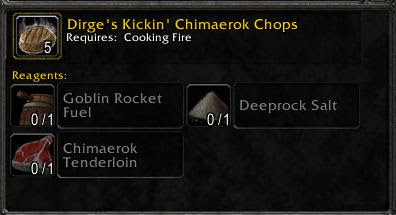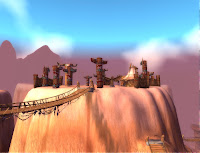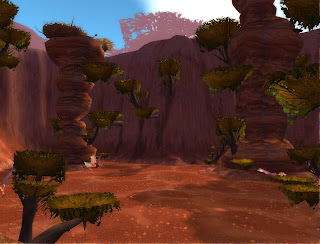Taste of Azeroth: Dirge's Kickin' Chimaerok Chops
It's a strange thing to salivate over digital food, but the sweet and savory local specialties throughout Azeroth look delicious to me. And so, I bring you a new series: Taste of Azeroth! Each post will highlight a different dish found within the World of Warcraft, and speculate on how it could be recreated.
 Today's focus is Dirge's Kickin' Chimaerok Chops. Only the most persistent cooks will have the know-how to produce this fiery entree, as the epic-quality recipe is a reward earned during the arduous Scepter of the Shifting Sands questline, though it would be possible to pick it up (at a hefty price) from the Auction House. Invented by Gadgetzan-based goblin butcher Dirge Quikcleave, this recipe uses goblin rocket fuel to add an extra kick. The chops are made from the tenderloin of elite Chimaerok, who inhabit the Isle of Dread off the coast of Feralas.
Today's focus is Dirge's Kickin' Chimaerok Chops. Only the most persistent cooks will have the know-how to produce this fiery entree, as the epic-quality recipe is a reward earned during the arduous Scepter of the Shifting Sands questline, though it would be possible to pick it up (at a hefty price) from the Auction House. Invented by Gadgetzan-based goblin butcher Dirge Quikcleave, this recipe uses goblin rocket fuel to add an extra kick. The chops are made from the tenderloin of elite Chimaerok, who inhabit the Isle of Dread off the coast of Feralas.
Ingredients
Now let's recreate a meat-world version of this meal.
1. Goblin rocket fuel is made from firebloom and volatile rum. To give you an idea of its potency, just keep in mind that it's an essential component in various kinds of firework launchers. I estimate that Firebloom can best be approximated with a blend of cayenne and garlic, and you can likely find some volatile rum at any liquor store.
2. Deeprock Salt can't be collected from the Azerothian landscape, so its ultimate source is unclear (though its name suggests it originates underground, perhaps in Blackrock Mountain). The salt used in this recipe is unprocessed (as opposed to Refined Deeprock Salt, for example), so coarse sea salt would be a good substitute.
3. Chimaeroks are moderately large animals, yet still dainty enough to fly. Their sharp teeth suggest that they're carnivorous, and they have horns (as well as two heads). Recipes like Kohda's Kickin' Chops on Nourish use pork, but I think lamb would better approximate Chimaerok in terms of physiology (at least as far as any mammal can approximate a two-headed armless horned flying digital beast).
Mix together your rum, cayenne, minced garlic, and salt. Slice up the tenderloins into individual servings and add them to this mixture in a sealable container or ziploc bag, and let the whole thing marinate for several hours. Grill or roast to perfection, and enjoy!
 Today's focus is Dirge's Kickin' Chimaerok Chops. Only the most persistent cooks will have the know-how to produce this fiery entree, as the epic-quality recipe is a reward earned during the arduous Scepter of the Shifting Sands questline, though it would be possible to pick it up (at a hefty price) from the Auction House. Invented by Gadgetzan-based goblin butcher Dirge Quikcleave, this recipe uses goblin rocket fuel to add an extra kick. The chops are made from the tenderloin of elite Chimaerok, who inhabit the Isle of Dread off the coast of Feralas.
Today's focus is Dirge's Kickin' Chimaerok Chops. Only the most persistent cooks will have the know-how to produce this fiery entree, as the epic-quality recipe is a reward earned during the arduous Scepter of the Shifting Sands questline, though it would be possible to pick it up (at a hefty price) from the Auction House. Invented by Gadgetzan-based goblin butcher Dirge Quikcleave, this recipe uses goblin rocket fuel to add an extra kick. The chops are made from the tenderloin of elite Chimaerok, who inhabit the Isle of Dread off the coast of Feralas.Ingredients
- 1 barrel of Goblin Rocket Fuel
- 1 pinch of Deeprock Salt
- 1 Chimaerok Tenderloin
Now let's recreate a meat-world version of this meal.
1. Goblin rocket fuel is made from firebloom and volatile rum. To give you an idea of its potency, just keep in mind that it's an essential component in various kinds of firework launchers. I estimate that Firebloom can best be approximated with a blend of cayenne and garlic, and you can likely find some volatile rum at any liquor store.
2. Deeprock Salt can't be collected from the Azerothian landscape, so its ultimate source is unclear (though its name suggests it originates underground, perhaps in Blackrock Mountain). The salt used in this recipe is unprocessed (as opposed to Refined Deeprock Salt, for example), so coarse sea salt would be a good substitute.
3. Chimaeroks are moderately large animals, yet still dainty enough to fly. Their sharp teeth suggest that they're carnivorous, and they have horns (as well as two heads). Recipes like Kohda's Kickin' Chops on Nourish use pork, but I think lamb would better approximate Chimaerok in terms of physiology (at least as far as any mammal can approximate a two-headed armless horned flying digital beast).
Mix together your rum, cayenne, minced garlic, and salt. Slice up the tenderloins into individual servings and add them to this mixture in a sealable container or ziploc bag, and let the whole thing marinate for several hours. Grill or roast to perfection, and enjoy!

























































0 Comments:
Post a Comment
<< Home